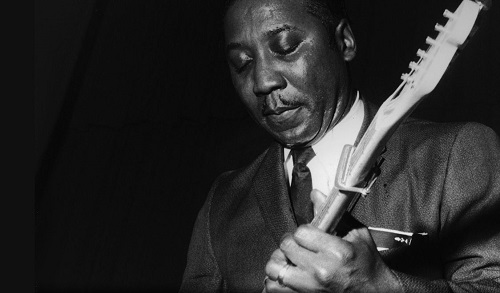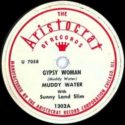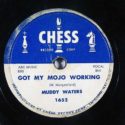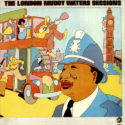Muddy Waters
| Track | Album / Single |
|---|---|
| I Be’s Troubled / Country Blues (Number One) | Plantation Recordings |
| I Can’t Be Satisfied / I Feel Like Going Home | Aristocrat 1305 |
| Rollin' Stone | Chess 1426 |
| She Moves Me | Chess 1490 |
| Standing Around Crying | Chess 1526 |
| Forty Days And Forty Nights | Chess 1620 |
| I Love The Life I Live | Chess 1630 |
| She's Nineteen Years Old | Chess 1704 |
| My Dog Can't Bark | Chess 1937 |
| Long Distance Call | Live (At Mr. Kelly's) |
| You Can't Lose What You Ain't Never Had | One More Mile |
| Deep Down In Florida | Hard Again |

Contributor: Keith Shackleton
When John Work III and Alan Lomax arrived on Stovall’s Plantation on August 31, 1941, they could scarcely have imagined what that day’s recording would give them. They found a man who was a living bridge between the primeval delta blues of men like Charlie Patton, and the future developments in the blues of the American south and eventually the rest of the world. McKinley Morganfield, a.k.a. Muddy Waters, was 28: his skills were fully formed and his voice carried considerable weight of experience. Take a listen to I Be’s Troubled from that Plantation session – it’s an assured, confident performance. Next, check out Country Blues (Number One), and feel Muddy’s power. Much later, career almost done, he would still state a preference for the simplicity of pure acoustic sessions.
Jump forward seven years or so, and listen to the same songs in greater fidelity (retitled I Can’t Be Satisfied and I Feel Like Going Home), recorded in Chicago for Sam Goldberg and the Chess brothers … they were a sensation. The first pressing of Aristocrat 1305 sold out in around a day. These are the first stirrings of Muddy’s classic blues: he’s no longer leaving in the morning and riding the blinds. He’s lived that part of his life. Set out against the steady chug of Ernest ‘Big’ Crawford’s bass, Muddy declaims and testifies and whips that slide with greater fervour. This is the prototype sound of the workaday world of factories and streetcars, and it convinced Leonard and Phil Chess to divorce themselves from Aristocrat, because this was the way forward – the electric blues.
Well, my mother told my father
Just before I was born
“Got a boy child comin’, gonna be,
He’s gonna be a rollin’ stone.”
Sure enough he’s a rollin’ stone
1950. Rollin’ Stone has the sound that inspired a generation. The power of his voice, the volume and distortion of the guitar, comes straight from the clubs. It’s just one man, one instrument, but it sounds huge, and even today, quite unique. That elastic space around the phrasing, the bass notes carry the vocal lines, our anticipation when they pause, the relief of tension with a flourish on the high strings and that voice, soaring to a higher register.
Out of the studio, however, Muddy had already moved on from amplified Delta blues. Leonard Chess took a while to be convinced, but the line-up that was absolutely killing it on stage was so popular, the inevitable had to happen. The virtuoso harmonica of Little Walter, the versatility of guitarist and songwriter Jimmy Rogers, and solid drummer Elgin Evans, began to feature strongly on Waters’ Chess sessions. It was round about this time too that Muddy met his soul brother Otis Spann, a swinging, fluid piano player who rounded out the band line-up and would be at the heart of it for nigh on twenty years.
For a great example of Walter’s harp in the mix, listen to She Moves Me, from a vital session on July 11, 1951. Walter had already assisted in the studio on Waters’ staples like Long Distance Call, Honey Bee and Louisiana Blues, but here he plugs his microphone into an amplifier rather than the sound board and – seriously screwing with Leonard Chess’s nerves – it was nothing short of a revolution. Country had most definitely become city. Chess elbowed Evans, who wasn’t quite up to the mark, out of the way and hammered out time on the bass drum fit to raise the dead, and Walter weaves his harp lines around it, in and out, intricate yet effortless. More than fifty years on, just listen. Imagine being there and hearing this for the first time. And they weren’t done. Bristling with creativity, they recorded Still A Fool, Muddy bellowing out and ripping into his strings, Walter backing on guitar this time. There’s no relief here, no solo or bridge or key change. It’s harsh, relentless and truly compelling.
Over the course of the next three years or so, the core of Waters, Rogers, Walter and Spann laid down the meat of Muddy Waters’ classic catalogue: Hoochie Coochie Man, Baby Please Don’t Go, I’m Ready, Sugar Sweet … winning tunes all, and if one of those good gentlemen wasn’t available, there was always someone waiting in the wings ready to move in and show what he could do. This was a common theme as the years went by: Muddy attracted great musicians into his line-up, they’d get a high profile, they’d move on to do their own shows and make their own recordings. Case in point: Walter’s massive hit harmonica instrumental Juke, on the chart for twenty weeks and a #1 hit, made him a star in his own right. If Walter was busy, well, seventeen year old Junior Wells was pretty sure he had what it took. Play Standing Around Crying, and the evidence is clear … he had. Rogers and Evans keep the beat steady, Muddy gives one of his most committed vocal performances and Wells blows his heart out with searing distortion.
Round about this time, the blues had a baby, and they called it rock and roll. Blues was the established sound, but this feisty newcomer shook Muddy and his band. A skinny guy called Chuck Berry was changing the way Chess approached popular music, and Elvis Presley’s regional success was soon to burst forth at a national level. Club audiences wanted the new sounds, and something had to give. For a time Muddy didn’t pick up his guitar. Unable to make the transition, Jimmy Rogers was another casualty. Drummers Francis Clay and Fred Below could cruise along with the new rhythms more effectively than Evans’ basic timekeeping … they were in.
Pat Hare (borrowed from James Cotton’s band) and Hubert Sumlin (stolen from Howlin’ Wolf’s) were the guitar slingers who made a real difference to the new Waters band sound. Listen to Hare’s proto-Berry stylings on Forty Days And Forty Nights, and feel the back beat. Check out Clay’s battering lead-in to Walter’s harp solo on I Love The Life I Live – Hare and Sumlin fall in behind, one with the walking line, one comping the chords, Willie Dixon sprightly on the bass, Clay dragging that vital fraction of a second behind … your feet can’t help but move. All Aboard, Don’t Go No Farther, Got My Mojo Working … this band could really fly.
There was still room for the down home: with Muddy in charge, how could there not be? My personal favourite of his, She’s Nineteen Years Old, was recorded in 1958. Times had most definitely changed, and the cut on the A-side, Close To You, sounds rather desperate … was he trying to channel Elvis with that forced laugh? Uh-huh? But the slow blues, often dragged out live at a slovenly pace, has the deepest of deep soul feeling, and hark at the power of the ending … imagine Chess scrabbling for the faders as the meter needles hit the end stops. It’s distorted as hell, and it’s fantastic.
There’s still two years to go before a British teenager, carrying his guitar, spots a former schoolmate at Dartford station who has The Best Of Muddy Waters and Chuck Berry’s Rockin’ At The Hops tucked under his arm. There are eight years to go before a folk singer from Hibbing, Minnesota outrages British folkies by performing with an electric blues band.
I can’t think why the folkies were so upset. Muddy had already blown their ears off when touring there in 1958, and the band dazzled the American public at the Newport Jazz Festival in 1960 (that joyful foxtrot with James Cotton during Got My Mojo Working – see top clip). The British invasion bands checked Muddy and his contemporaries, the British jazz scene feted him, and the profile of American indigenous music was raised by these upstart ‘imports’, paying it back.
But as the rock scene of the mid to late 60s developed, and more people wanted their blues played at thunderous volume with extreme technical dexterity by guys who were not necessarily, er … born bluesmen, let’s say. Chess were convinced that the way to sell Muddy was to shoehorn him into situations where he might not have been entirely comfortable, but with their eyes entirely on the financial prize:
Why not team him up with those new British rock musicians? – The London Sessions
How about with the best of our American blues boys? – Fathers And Sons
Let’s go see those guys who backed Bob Dylan – The Muddy Waters Woodstock Album
How about a psychedelic record! – Electric Mud
Let’s do another! – After The Rain
How about a horn section and organ? – Brass And The Blues
OK, I can be a tad harsh on these records, and they’re not going to challenge my selection, but some of them are worth some of your time. Jimi Hendrix checked Herbert Harper’s Free Press News, from Electric Mud, as an inspiration, for example …
… but every now and then, Muddy would just put out something which reminded people what he did best, and occasionally he’d sound damn frustrated doing it too. Kudos to Robert Gordon for pointing out an example of this in his excellent Waters biography. Try My Dog Can’t Bark (1964), a vicious little ditty cut from the same cloth as the Muddy standard Tiger In Your Tank. It buzzes like a hive of angry bees, and is entirely the kind of thing the Waters band should have been regularly laying down. What about that slide guitar? Whaddya think of that? How about James Cotton’s evil harp?
As time went by, Muddy did get back to what he did best, despite (or maybe because of) the collapse of Chess, being screwed out of tour money, and a debilitating car accident with a long recovery period for the great man. Under new management, the turning point in his career was a three week stint in a Chicago club called Mr. Kelly’s in 1971. In fine voice, with a solid band, playing slide … you can hear the results on the live album, and I’ll go for another of my deep blues favourites, Long Distance Call. Muddy says, “I’ma kill that mule …” (the one that’s kickin’ in her stall, people, if you catch the drift) and rips his slide like the old days, and Paul Oscher closes out the solo with some judicious harp blasts: blues heaven. And listen to Muddy take it home, rapping out a fine tale, with those falsetto “another myooooo-oole” swoops. Very good indeed.
Remember how I was saying how Muddy loved the simplicity of his pared down acoustic blues? Well here’s the proof: a Swiss radio studio recording session from 1972, available on the One More Mile compilation … just Muddy singin’ and slidin’, backed only by Mojo Buford on harp, and Louis Myers on guitar. I’ll pick You Can’t Lose What You Ain’t Never Had from this bunch of tunes. It swings, and it turns around and around, and it goes more than six minutes, and these boys wouldn’t go that long if they weren’t having tremendous fun. Which of course they are!
The final cap on Muddy’s long career came at Columbia/Sony, on the Blue Sky label, where, with the help of Johnny Winter and a clutch of excellent and sympathetic blues musicians, he made four albums, mostly excellent (if occasionally Johnny features a weeny bit too much, but we mustn’t grumble, dear readers, we really mustn’t). The first one, Hard Again, was recorded in 1976, and it might be Muddy’s punk album … the contemporary sound bristles with energy and is razor sharp. The tone on James Cotton’s harmonica is savage.
Though the old standards were re-recorded, newer songs were coming through, and I’ll pick Deep Down In Florida for that reason, though in truth, any of this record will do. I have a deep love for the same song on the subsequent live album Muddy ‘Mississippi’ Waters – Live where it stretches out to a lazy ten minutes or so, and every second is vital. I’m Ready is a super album, and the final one for Blue Sky, King Bee, has its moments too. I’ve run out of my ten selections, and I’ve written far too many words, but do have a listen to Clouds In My Heart.
Muddy died in 1983, aged 70. I’m not sure I can express this properly, and it might sound weird, but it doesn’t feel that long ago, it feels like he’s still around and he’ll always be with us. I guess that’s because of what he left us, a giant who bestrode the twentieth century like a colossus, at the centre of black American culture. He’s one of those icons instantly recognisable to anyone with an interest in music. All you have to do is mention a single name, and people know who you mean, and how vital they were. Jimi, Otis, Miles, Janis, Aretha, Kurt …
Muddy. Ain’t that a man?
Muddy Waters (McKinley Morganfield) 1913-1983
McKinley Morganfield’s birth date has been cited as April 4, 1913, 1914, or 1915, find out more here.
Otis Spann (1930-1970)
Jimmy Rogers (1924-1997)
Little Walter (1930-1968)
Elgin Evans (1909-1966)
Willie Dixon (1915–1992)
Junior Wells (1934-1998)
Pat Hare (1930-1980)
Hubert Sumlin (1931-2011)
Francis Clay (1923-2008)
Fred Below (1926-1988)
Paul Oscher (1947-2021)
Louis Myers (1929–1994)
George “Mojo” Buford (1929-2011)
James Cotton (1935-2017)
Johnny Winter (1944-2014)
Of the 4 tracks mentioned right at the top of Keith’s post, I Be’s Troubled and Country Blues (Number One) can be found on The Complete Plantation Recordings. I Can’t Be Satisfied and I Feel Like Going Home and all of the Chess singles (apart from My Dog Can’t Bark) can be found on the 50 track album The Anthology (1947–1972) (available at a very reasonable price on Amazon) and all of Keith’s 14 choices are on our Spotify playlist.
The Complete Muddy Waters Discography
Muddy Waters – Rock & Roll Hall of Fame
Delta Blues Museum, Clarksdale, Mississippi
“Can’t Be Satisfied: The Life and Times of Muddy Waters” by Robert Gordon
Muddy Waters set at the Copenhagen Jazz festival, October 1968 (YouTube)
Muddy Waters set at the Molde Jazz Festival in Norway, August 1977 (YouTube)
Muddy Waters biography (Apple Music)
Read more of Keith Shackleton’s musings on music at his website, The Riverboat Captain.
TopperPost #557















“You got a boy child coming, gonna be a son of a gun” – Muddy was that son of a gun and you’ve captured him, here, bang to rights Keith. Brilliant Toppermost – the Newport Mojo clip set the bar mighty high for a starter but you followed it with some evocative writing and constantly interesting selections including some surprises which I’m going to look into. Only minor gripe on my part is that I’d like to have had Louisiana Blues in there. But everyone will have their favourites. Agree also, that he’s one of the relatively few artists that warrant the word “icon”.
Just brilliant. Superb writing and great selections – and to top it off Rory gets in here as well. Might have to have ‘Screamin and Cryin’ or ‘Sad Sad Day’ in my top ten, but can’t argue with anything here.
Keith, you’ve done what I didn’t think was possible – a Muddy Waters toppermost without Manish Boy – yet you’ve done it, and there’s nothing here I’d remove to make room for it.
Most kind, gentlemen, your comments mean a lot to me. Manish Boy and Hoochie Coochie Man.. great tunes, the version of Manish Boy on Hard Again is a ripper. I kinda worked backwards with Muddy, as you often do when discovering an artist. I see I used the term “angry bees” in that article too.
Great job, though Mannish Boy with The Band from The Last Waltz is essential. I’ll take issue on The Woodstock Album. The project was instigated by Levon Helm and Henry Glover, not by Chess, though Chess is on the label. It was all Levon’s idea. Only Levon Helm and Garth Hudson of The Band appear on the album. I saw Muddy Waters in 1968, and it’s still one of the best two or three shows I’ve ever seen.
A later thought. The Woodstock Album (1975) was the first outside venture for Levon Helm and Henry Glover’s RCO Studio. It has a consistent laid-back feel … very much Louis Jordan, with Levon’s favourite cover, Caldonia as a template. That was also done by Muddy on The Last Waltz though not filmed (and is on The Complete Last Waltz box set). The Woodstock tracks utilised Pinetop Perkins and Bob Margolin from Muddy’s band, with Levon Helm on drums, Fred Carter on bass, Paul Butterfield on harmonica, Howard Johnson on sax, plus Garth Hudson on organ, accordion and sax. I wouldn’t put any of the tracks in the Toppermost, but it’s a different relaxed feel, and I prefer it to any of the Johnny Winters albums. “Funny Sounds” is the most typical in vocal, but then you have strange accordion and organ behind it. Worth a listen.
His last for Chess, wasn’t it.. like I say, I can be harsh on them, but it’s good to spend some time with those records.